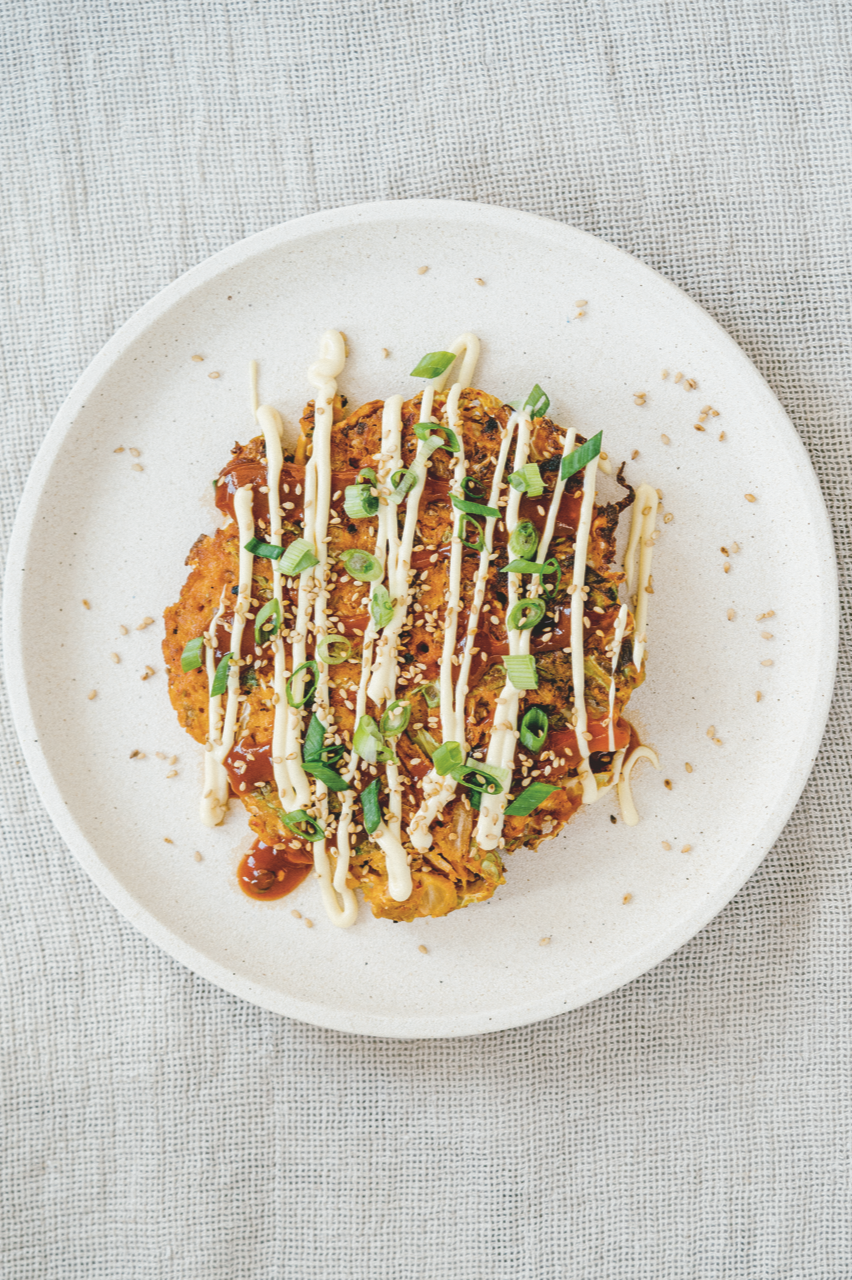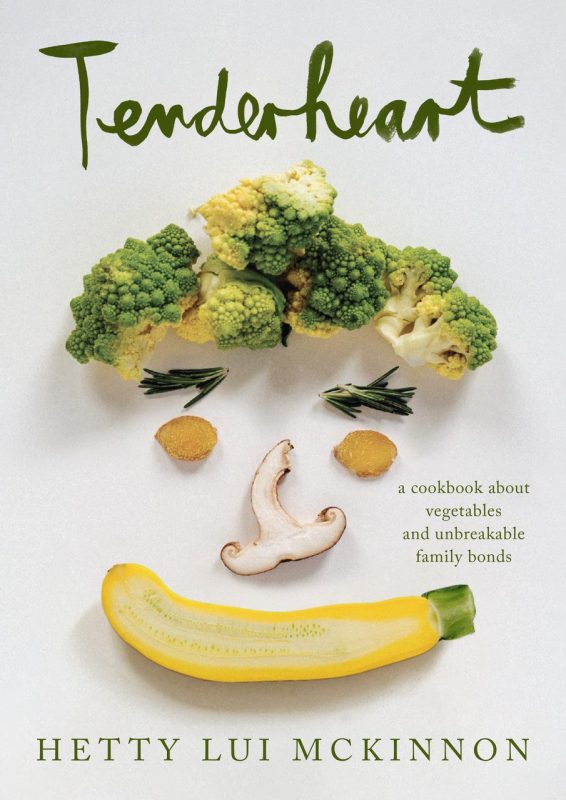Cabbage and Kimchi Okonomiyaki

From Tenderheart: A Cookbook About Vegetables and Unbreakable Family Bonds © 2022 by Hetty Lui McKinnon. Excerpted by permission of Alfred A. Knopf, a division of Penguin Random House LLC. All rights reserved. No part of this excerpt may be reproduced or reprinted without permission in writing from the publisher.
Okonomiyaki is a beloved savory pancake from Japan, where the dish differs from region to region—Hiroshima-style is a layered pancake, while in Osaka it is made by mixing all the ingredients together before being fried. This recipe is akin to an Osaka-style okonomiyaki, which is traditionally made primarily with cabbage, flour and eggs. The dish is ultimately adaptable—in Japanese, okonomi means “how you want it” or “what you like” and yaki means “grill.” Cabbage is a common filling, but while kimchi is not, it imparts a salty tang and welcome spice. I’ve used rice flour in this version, which makes it a bit lighter, but regular flour works, too. Kewpie, the Japanese brand of mayonnaise, is essential for topping okonomiyaki, but good-quality whole-egg mayonnaise also works fine.
MAKES FOUR 6-INCH (15 CM) PANCAKES
- 1 cup minus 1 tablespoon (150 g) rice flour or 1 ¼ cups (150 g) all-purpose flour
- ½ teaspoon baking powder
- sea salt and white pepper
- ½ teaspoon sugar
- 3 large eggs, lightly beaten
- ¾ cup (180 ml) Vegan Dashi (recipe below) or vegetable stock
- 1 tablespoon white (shiro) miso
- 1 cup (200 g) regular or vegan kimchi, drained and chopped
- ½ small head green or savoy cabbage (about 14 oz/400 g), finely chopped
- 2 green onions, finely sliced, plus extra to serve
- Neutral oil
- Kewpie mayonnaise or regular good-quality mayonnaise, to serve
- handful of toasted white sesame seeds, to serve
Gochujang ketchup:
- 4 teaspoons soy sauce or tamari
- 1 teaspoon toasted sesame oil
- 4 teaspoons gluten-free gochujang
- 1/4 cup (60ml) ketchup
To make the gochujang ketchup, whisk together all the ingredients with 2 ½ tablespoons of water in a bowl. Set aside.

In a large bowl, whisk together the flour, baking powder, ½ teaspoon of sea salt and the sugar to combine. Add the egg, dashi or vegetable stock and miso and stir to form a batter. Add the kimchi, cabbage and green onion and fold everything together until well combined.
Heat a medium skillet over medium heat. Add a drizzle of oil and spoon one-quarter of the batter into the pan, using a spatula to shape the pancake into a neat round. Reduce the heat to medium low, then cover and cook for 4–5 minutes, until the underside is golden, lowering the heat as necessary if the okonomiyaki threatens to burn. Lift the lid and flip the pancake with a wide spatula. If parts of the pancake fall off during the flip, simply tuck them back in to reassemble the round. If the pan is dry, add a little more oil and swirl it under the pancake. Cover and cook for another 4–5 minutes, until both sides are golden. Repeat with the rest of the batter.
Place a pancake on a serving plate and season with sea salt and white pepper. Drizzle with some of the gochujang ketchup, squeeze or spoon over some mayonnaise, sprinkle with the sesame seeds and scatter with green onion.
Gluten-free
Veganize: replace the eggs with flax eggs
Vegetable swap: cabbage – carrots, Brussels sprouts
Vegan Dashi
Dashi is a foundational ingredient in Japanese cooking. The soup stock is infused with a distinct umami flavor, adding richness and depth to countless dishes, such as miso soup, ramen broth, chawanmushi (a savory egg custard) and nimono (simmered dishes), and is often mixed into flour bases for grilled foods like okonomiyaki and takoyaki. Simple and adding a refined elegance to meals, dashi is often made from kombu and smoky katsuobushi (bonito flakes), but can also be created with other ingredients, such as dried shiitake mushrooms. Don’t rinse kombu before soaking—the white powdery substance found on the surface occurs as part of the natural drying process and imparts lots of umami flavor. This is an effortless way to make dashi at home.
MAKES 4–5 CUPS (1–1.25 LITERS)
- 5 × 6-inch (12.5 cm × 15 cm) sheet of dried kombu (10 g)
- 4 dried shiitake mushrooms
- 5 ¼ cups (1.25 liters) filtered water
Place the kombu, shiitake mushrooms and filtered water in a saucepan and set over medium-low heat until it reaches a very low simmer, without boiling. This should take about 10 minutes. Remove from the heat and remove the kombu and shiitake.
The kombu and shiitake can be reused to make one more batch of dashi. Dashi can be cooled and stored in the fridge for up to 1 week or frozen for up to 3 months.

Hetty Lui McKinnon is a Chinese Australian cook and food writer. A James Beard Foundation finalist, she is the author of four other cookbooks, including the much-loved To Asia, With Love (2021), the award-winning Family: New Vegetarian Comfort Food to Nourish Every Day (2019), Neighbourhood: Hearty Salads and Plant-Based Recipes from Home and Abroad (2017), and Community: Salad Recipes from Arthur Street Kitchen (2014). Hetty is also the editor and publisher of multicultural food journal Peddler and the host of the magazine’s podcast The House Specials. She is a regular recipe contributor to The New York Times, Bon Appetit, Epicurious.com, and ABC Everyday; and her recipes have appeared in Food52, the Guardian, The Washington Post and more. Born and raised in Sydney, she now resides in Brooklyn, New York.
